Page 47 of 707

Push the button on the RKE transmitter twice within five
seconds to open a power sliding door. When the door is
fully open, pushing the button twice within five seconds
a second time will close the door.
There are power sliding side door switches located on the
B-pillar trim panel, just in front of the power sliding door
for the rear seat passengers and in the overhead console
for the driver and passengers. Pushing the switch once
will open the power sliding door. If the switch is pushed
while the door is under a power cycle, the door will
reverse direction.
NOTE:The power sliding side door must be unlocked
before the power sliding door switches will operate. If the inside or outside door handles are used while the
power sliding side door is activated, the power sliding
door feature will be canceled and will go into manual
mode.
To avoid unintentional operation of the power sliding
doors from the rear seats, push the power sliding door
Power Sliding Door Switch
2
THINGS TO KNOW BEFORE STARTING YOUR VEHICLE 45
Page 49 of 707
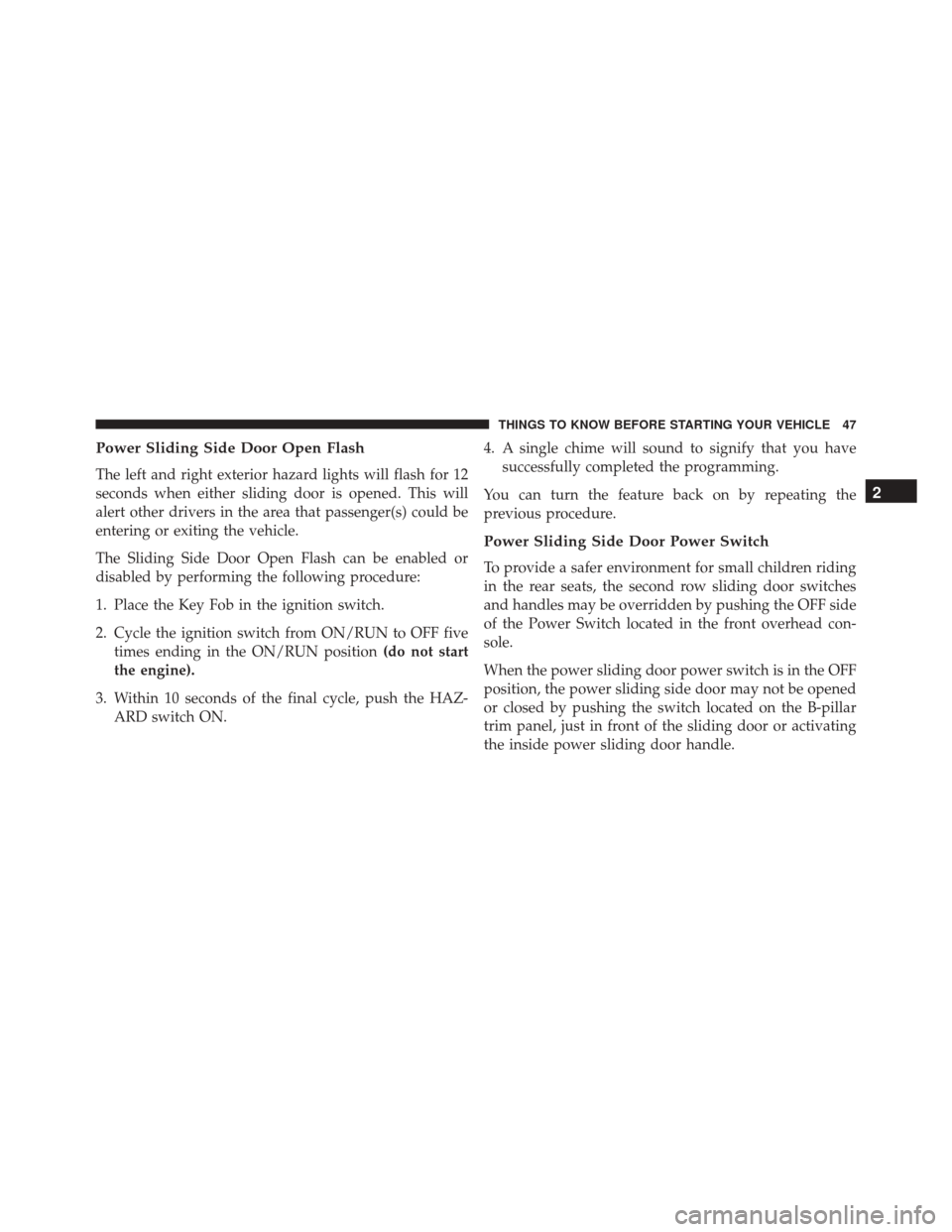
Power Sliding Side Door Open Flash
The left and right exterior hazard lights will flash for 12
seconds when either sliding door is opened. This will
alert other drivers in the area that passenger(s) could be
entering or exiting the vehicle.
The Sliding Side Door Open Flash can be enabled or
disabled by performing the following procedure:
1. Place the Key Fob in the ignition switch.
2. Cycle the ignition switch from ON/RUN to OFF fivetimes ending in the ON/RUN position (do not start
the engine).
3. Within 10 seconds of the final cycle, push the HAZ- ARD switch ON. 4. A single chime will sound to signify that you have
successfully completed the programming.
You can turn the feature back on by repeating the
previous procedure.
Power Sliding Side Door Power Switch
To provide a safer environment for small children riding
in the rear seats, the second row sliding door switches
and handles may be overridden by pushing the OFF side
of the Power Switch located in the front overhead con-
sole.
When the power sliding door power switch is in the OFF
position, the power sliding side door may not be opened
or closed by pushing the switch located on the B-pillar
trim panel, just in front of the sliding door or activating
the inside power sliding door handle.
2
THINGS TO KNOW BEFORE STARTING YOUR VEHICLE 47
Page 50 of 707
Sliding Side Door Child Protection Lock
To provide a safer environment for small children riding
in the rear seats, the sliding doors are equipped with a
Child Protection Door Lock system.
NOTE:When the Child Protection Door Lock system is
engaged, the door can be opened only by using the
outside door handle even though the inside door lock is
in the unlocked position.
To Engage The Child Protection Door Lock
1. Open the sliding side door.
2. Slide the Child Protection Door Lock control inward (toward the vehicle) to engage the Child Protection
Door Lock.
Overhead Console Power Sliding Door Power Switch
1 — Left Sliding Door
2 — Liftgate
3 — Right Sliding Door
4 — Power Switch 48 THINGS TO KNOW BEFORE STARTING YOUR VEHICLE
Page 51 of 707
3. Repeat Steps 1 and 2 on the opposite sliding door.NOTE:
•
After engaging the Child Protection Door Lock, always
test the door from the inside to make certain it is in the
desired position.
• When the Child Protection Door Lock system is en-
gaged, (even if the inside door lock is in the unlocked
position) the door can be opened only by using the
outside door handle, the RKE transmitter, the switches
on the overhead console or the switches located on the
trim panel just in front of the power sliding door.
• The power sliding side door will operate from the
switches located on the B-pillar trim panel, just in front
of the power sliding door, regardless of the Child
Protection Door Lock lever position. To avoid unin-
tentional operation of the power sliding door from
the rear seats, push the “OFF” Master Lock Out
Switch located in the front overhead console, next to
the driver.
Child Protection Door Lock
2
THINGS TO KNOW BEFORE STARTING YOUR VEHICLE 49
Page 58 of 707
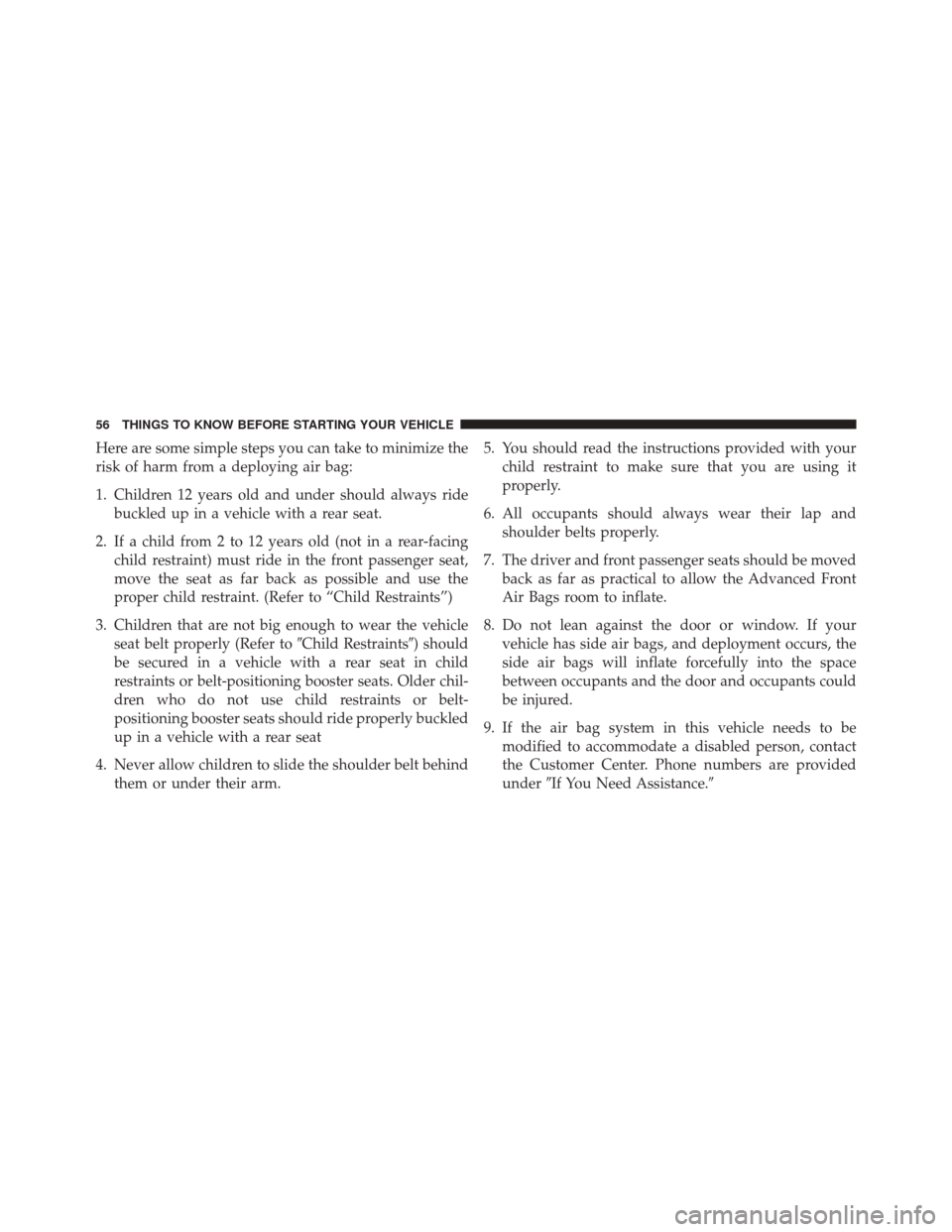
Here are some simple steps you can take to minimize the
risk of harm from a deploying air bag:
1. Children 12 years old and under should always ridebuckled up in a vehicle with a rear seat.
2. If a child from 2 to 12 years old (not in a rear-facing child restraint) must ride in the front passenger seat,
move the seat as far back as possible and use the
proper child restraint. (Refer to “Child Restraints”)
3. Children that are not big enough to wear the vehicle seat belt properly (Refer to �Child Restraints�) should
be secured in a vehicle with a rear seat in child
restraints or belt-positioning booster seats. Older chil-
dren who do not use child restraints or belt-
positioning booster seats should ride properly buckled
up in a vehicle with a rear seat
4. Never allow children to slide the shoulder belt behind them or under their arm. 5. You should read the instructions provided with your
child restraint to make sure that you are using it
properly.
6. All occupants should always wear their lap and shoulder belts properly.
7. The driver and front passenger seats should be moved back as far as practical to allow the Advanced Front
Air Bags room to inflate.
8. Do not lean against the door or window. If your vehicle has side air bags, and deployment occurs, the
side air bags will inflate forcefully into the space
between occupants and the door and occupants could
be injured.
9. If the air bag system in this vehicle needs to be modified to accommodate a disabled person, contact
the Customer Center. Phone numbers are provided
under �If You Need Assistance.�
56 THINGS TO KNOW BEFORE STARTING YOUR VEHICLE
Page 62 of 707
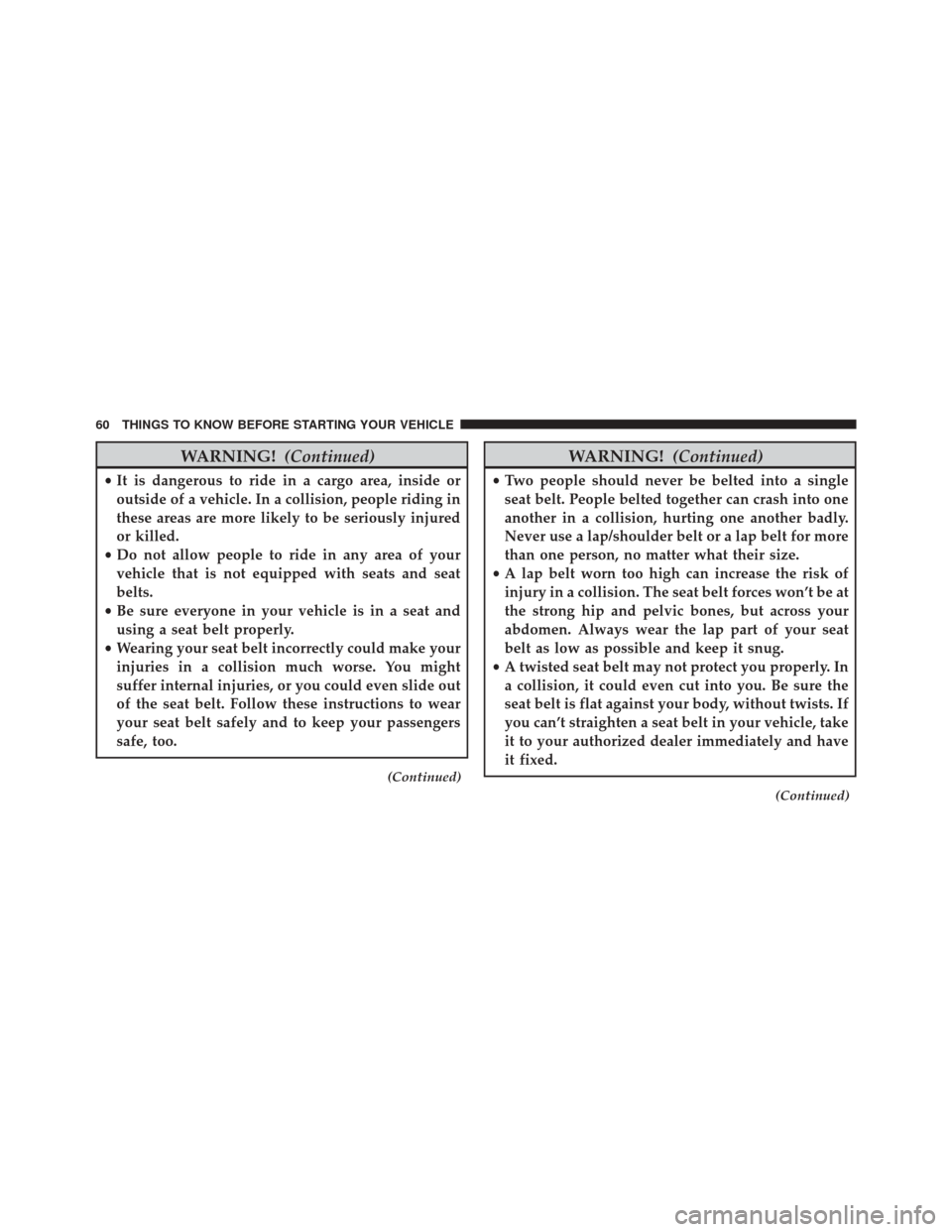
WARNING!(Continued)
•It is dangerous to ride in a cargo area, inside or
outside of a vehicle. In a collision, people riding in
these areas are more likely to be seriously injured
or killed.
• Do not allow people to ride in any area of your
vehicle that is not equipped with seats and seat
belts.
• Be sure everyone in your vehicle is in a seat and
using a seat belt properly.
• Wearing your seat belt incorrectly could make your
injuries in a collision much worse. You might
suffer internal injuries, or you could even slide out
of the seat belt. Follow these instructions to wear
your seat belt safely and to keep your passengers
safe, too.
(Continued)
WARNING! (Continued)
•Two people should never be belted into a single
seat belt. People belted together can crash into one
another in a collision, hurting one another badly.
Never use a lap/shoulder belt or a lap belt for more
than one person, no matter what their size.
• A lap belt worn too high can increase the risk of
injury in a collision. The seat belt forces won’t be at
the strong hip and pelvic bones, but across your
abdomen. Always wear the lap part of your seat
belt as low as possible and keep it snug.
• A twisted seat belt may not protect you properly. In
a collision, it could even cut into you. Be sure the
seat belt is flat against your body, without twists. If
you can’t straighten a seat belt in your vehicle, take
it to your authorized dealer immediately and have
it fixed.
(Continued)
60 THINGS TO KNOW BEFORE STARTING YOUR VEHICLE
Page 66 of 707
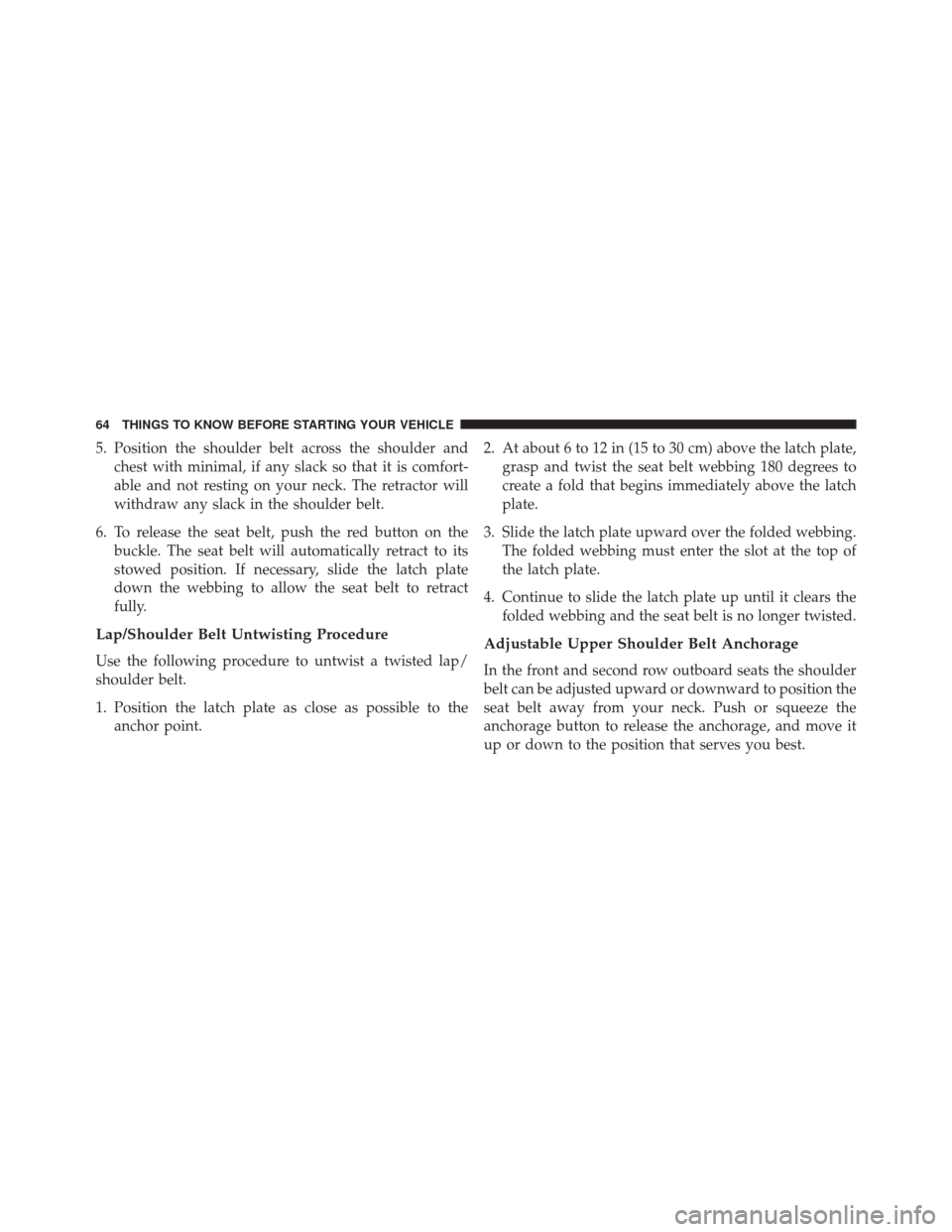
5. Position the shoulder belt across the shoulder andchest with minimal, if any slack so that it is comfort-
able and not resting on your neck. The retractor will
withdraw any slack in the shoulder belt.
6. To release the seat belt, push the red button on the buckle. The seat belt will automatically retract to its
stowed position. If necessary, slide the latch plate
down the webbing to allow the seat belt to retract
fully.
Lap/Shoulder Belt Untwisting Procedure
Use the following procedure to untwist a twisted lap/
shoulder belt.
1. Position the latch plate as close as possible to theanchor point. 2. At about 6 to 12 in (15 to 30 cm) above the latch plate,
grasp and twist the seat belt webbing 180 degrees to
create a fold that begins immediately above the latch
plate.
3. Slide the latch plate upward over the folded webbing. The folded webbing must enter the slot at the top of
the latch plate.
4. Continue to slide the latch plate up until it clears the folded webbing and the seat belt is no longer twisted.
Adjustable Upper Shoulder Belt Anchorage
In the front and second row outboard seats the shoulder
belt can be adjusted upward or downward to position the
seat belt away from your neck. Push or squeeze the
anchorage button to release the anchorage, and move it
up or down to the position that serves you best.
64 THINGS TO KNOW BEFORE STARTING YOUR VEHICLE
Page 67 of 707
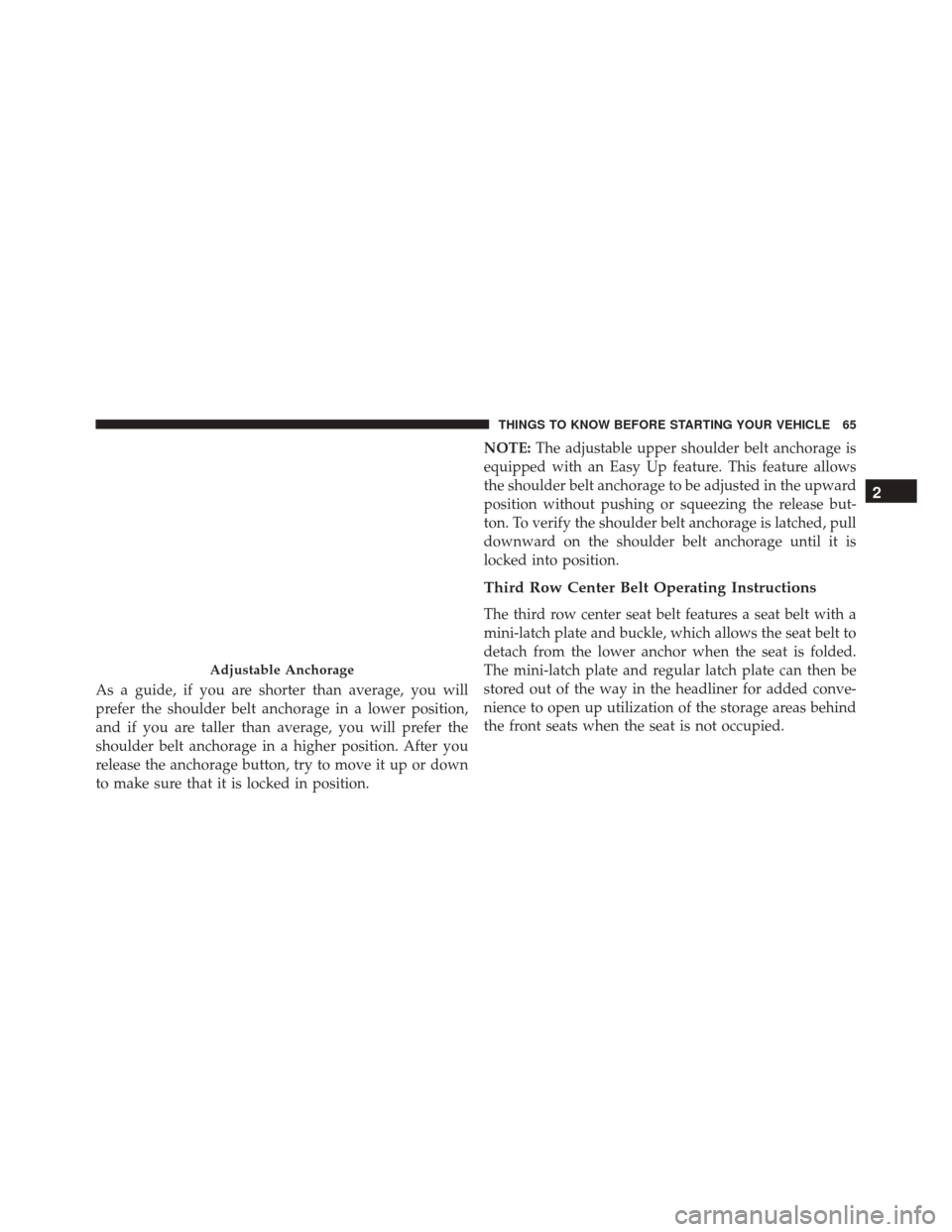
As a guide, if you are shorter than average, you will
prefer the shoulder belt anchorage in a lower position,
and if you are taller than average, you will prefer the
shoulder belt anchorage in a higher position. After you
release the anchorage button, try to move it up or down
to make sure that it is locked in position.NOTE:
The adjustable upper shoulder belt anchorage is
equipped with an Easy Up feature. This feature allows
the shoulder belt anchorage to be adjusted in the upward
position without pushing or squeezing the release but-
ton. To verify the shoulder belt anchorage is latched, pull
downward on the shoulder belt anchorage until it is
locked into position.
Third Row Center Belt Operating Instructions
The third row center seat belt features a seat belt with a
mini-latch plate and buckle, which allows the seat belt to
detach from the lower anchor when the seat is folded.
The mini-latch plate and regular latch plate can then be
stored out of the way in the headliner for added conve-
nience to open up utilization of the storage areas behind
the front seats when the seat is not occupied.
Adjustable Anchorage
2
THINGS TO KNOW BEFORE STARTING YOUR VEHICLE 65